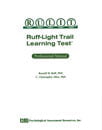
Ruff-Light Trail Learning Test rulit
For: Assess visuospatial learning and memory in ages 16-70 years
Reading Level: Adolescent - Elder Adult
Format: Paper-and-Pencil
Length: 5-15 minutes with a 60-minute delayed recall trial
Scoring: Hand Scored
Authors
Ronald M. Ruff, PhD, C. Christopher Allen, PhD
Description
The RULIT is a psychometrically sound measure of visuospatial learning and memory that is sensitive to right-hemisphere functioning. It does not require drawing skills, keen eyesight, good motor control, or refined visuospatial integration. The RULIT was designed to minimise (or eliminate) verbal mediation, to correlate with measures of visuospatial skill and visual memory, and to be sensitive to right hemisphere dysfunction. This test was developed because, although there are a number of instruments that tap the left-hemisphere skill of verbal learning and memory, there is no comparable visuospatial measure currently available.
The RULIT Professional Manual provides information on the clinical and theoretical background of the test, its development and standardisation, administration and scoring, interpretation, reliability and validity, and provides normative data for two age groups (16-54 years and 55-70 years).
The RULIT may be administered by any individual with appropriate training and background in psychological testing. Interpretation of RULIT scores for clinical or diagnostic purposes requires a clear understanding of brain-behaviour relationships and the medical and psychological factors that affect them.
The RULIT materials consist of the Manual, two Stimulus Cards, and the RULIT Test Booklet. The two Stimulus Cards provide alternate versions of the 15-step trail. Both versions have demonstrated high levels of reliability and strong evidence for validity. Each Stimulus Card contains a complex configuration of circles that are interconnected by lines. The respondent is asked to begin at the START circle and use an index finger to trace a line connecting the circles from the START to the END. At each circle (step) along the trail, there are three to five choices for the next step, but only one is correct. The administrator indicates whether the choice was correct, and the respondent keeps trying until the correct choice is made. This process continues through the 15-step trail. Successive trials are administered until the trail is recalled without an error on two consecutive trials.
Immediate Memory is assessed by the number of steps correctly completed in Trial 2. Learning is assessed by the number of trials to master the task and the cumulative number of errors across Trials 2 through 10 (or until the task is mastered). In addition to the Immediate Memory and Learning components of the test, Long-term Recall is evaluated by having the respondent retrace the trail after a 60-minute delay.
The RULIT normative group consisted of 307 volunteers who reported no history of psychiatric treatment, polydrug abuse, or neurological disorder. The group was stratified by age, gender and education. No meaningful differences were demonstrated based on gender or education. However, meaningful differences were demonstrated between the eldest age group (55-70 years) and all three of the other age groups (16-54 years). Raw score to T score conversion tables and cut-off scores based on percentile ranks are provided in the appendix.
NB: Prices are in Australian dollars inclusive of GST. NZ customers need to log in to view ex-GST prices.



